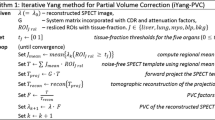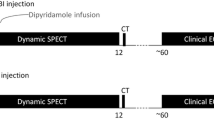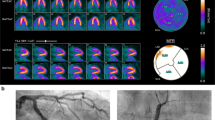Abstract
Background
Despite growing interest in coronary microvascular disease (CMVD), there is a dearth of mechanistic understanding. Mouse models offer opportunities to understand molecular processes in CMVD. We have sought to develop quantitative mouse imaging to assess coronary microvascular function.
Methods
We used 99mTc-sestamibi to measure myocardial blood flow in mice with MILabs U-SPECT+ system. We determined recovery and crosstalk coefficients, the influx rate constant from blood to myocardium (K1), and, using microsphere perfusion, constraints on the extraction fraction curve. We used 99mTc and stannous pyrophosphate for red blood cell imaging to measure intramyocardial blood volume (IMBV) as an alternate measure of microvascular function.
Results
The recovery coefficients for myocardial tissue (RT) and left ventricular arterial blood (RA) were 0.81 ± 0.16 and 1.07 ± 0.12, respectively. The assumption RT = 1 − FBV (fraction blood volume) does not hold in mice. Using a complete mixing matrix to fit a one-compartment model, we measured K1 of 0.57 ± 0.08 min−1. Constraints on the extraction fraction curve for 99mTc-sestamibi in mice for best-fit Renkin–Crone parameters were α = 0.99 and β = 0.39. Additionally, we found that wild-type mice increase their IMBV by 22.9 ± 3.3% under hyperemic conditions.
Conclusions
We have developed a framework for measuring K1 and change in IMBV in mice, demonstrating non-invasive µSPECT-based quantitative imaging of mouse microvascular function.




Similar content being viewed by others
Abbreviations
- CMVD:
-
Coronary microvascular disease
- FOV:
-
Field of view
- FBV:
-
Fractional blood volume
- IMBV:
-
Intramyocardial blood volume
- LV:
-
Left ventricle
- MBF:
-
Myocardial blood flow
- ROI:
-
Region of interest
- SPECT:
-
Single-photon emission-computed tomography
References
Camici PG, Crea F. Coronary microvascular dysfunction. N Engl J Med 2007;356:830-40.
Crea F, Camici PG, Bairey Merz CN. Coronary microvascular dysfunction: an update. Eur Heart J 2014;35:1101-11.
Bairey Merz CN, Shaw LJ, Reis SE, Bittner V, Kelsey SF, Olson M, et al. Insights from the NHLBI-Sponsored Women’s Ischemia Syndrome Evaluation (WISE) Study: Part II: gender differences in presentation, diagnosis, and outcome with regard to gender-based pathophysiology of atherosclerosis and macrovascular and microvascular coronary disease. J Am Coll Cardiol 2006;47:S21-9.
Murthy VL, Naya M, Taqueti VR, Foster CR, Gaber M, Hainer J, et al. Effects of sex on coronary microvascular dysfunction and cardiac outcomes. Circulation 2014;129:2518-27.
Gibson CM, Cannon CP, Daley WL, Dodge JT Jr, Alexander B Jr, Marble SJ, et al. TIMI frame count: a quantitative method of assessing coronary artery flow. Circulation 1996;93:879-88.
Schiattarella GG, Altamirano F, Tong D, French KM, Villalobos E, Kim SY, et al. Nitrosative stress drives heart failure with preserved ejection fraction. Nature 2019;568:351-6.
Mohammed SF, Hussain S, Mirzoyev SA, Edwards WD, Maleszewski JJ, Redfield MM. Coronary microvascular rarefaction and myocardial fibrosis in heart failure with preserved ejection fraction. Circulation 2015;131:550-9.
Bairey Merz CN, Pepine CJ, Walsh MN, Fleg JL. Ischemia and no obstructive coronary artery disease (INOCA): Developing evidence-based therapies and research agenda for the next decade. Circulation 2017;135:1075-92.
Murthy VL, Bateman TM, Beanlands RS, Berman DS, Borges-Neto S, Chareonthaitawee P, et al. Clinical quantification of myocardial blood flow using PET: Joint position paper of the SNMMI cardiovascular council and the ASNC. J Nucl Cardiol 2018;25:269-97.
Singh P, Schimenti JC, Bolcun-Filas E. A mouse geneticist’s practical guide to CRISPR applications. Genetics 2015;199:1-15.
Zhang H, Qiao H, Frank RS, Huang B, Propert KJ, Margulies S, et al. Spin-labeling magnetic resonance imaging detects increased myocardial blood flow after endothelial cell transplantation in the infarcted heart. Circ Cardiovasc Imaging 2012;5:210-7.
Raher MJ, Thibault H, Poh KK, Liu R, Halpern EF, Derumeaux G, et al. In vivo characterization of murine myocardial perfusion with myocardial contrast echocardiography: Validation and application in nitric oxide synthase 3 deficient mice. Circulation 2007;116:1250-7.
Croteau E, Renaud JM, McDonald M, Klein R, DaSilva JN, Beanlands RS, et al. Test-retest repeatability of myocardial blood flow and infarct size using (1)(1)C-acetate micro-PET imaging in mice. Eur J Nucl Med Mol Imaging 2015;42:1589-600.
Feher A, Sinusas AJ. Quantitative assessment of coronary microvascular function dynamic single-photon emission computed tomography, positron emission tomography, ultrasound, computed tomography, and magnetic resonance imaging. Circulation 2017;10:e006427.
Mohy-Ud-Din H, Boutagy NE, Stendahl JC, Zhuang ZW, Sinusas AJ, Liu C. Quantification of intramyocardial blood volume with (99 m)Tc-RBC SPECT-CT imaging: A preclinical study. J Nucl Cardiol 2018;25:2096-111.
Klein R, Beanlands RSB, deKemp RA. Quantification of myocardial blood flow and flow reserve: Technical aspects. J Nucl Cardiol 2010;17:555-70.
van der Have F, Vastenhouw B, Ramakers RM, Branderhorst W, Krah JO, Ji C, et al. U-SPECT-II: An ultra-high-resolution device for molecular small-animal imaging. J Nucl Med 2009;50:599-605.
Johnson LC, Guerraty MA, Moore SC, Metzler SD. Quantification of myocardial uptake rate constants in dynamic small-animal SPECT using a cardiac phantom. Phys Med Biol 2019;64:065018.
Kober F, Iltis I, Cozzone PJ, Bernard M. Myocardial blood flow mapping in mice using high-resolution spin labeling magnetic resonance imaging: Influence of ketamine/xylazine and isoflurane anesthesia. Magn Reson Med 2005;53:601-6.
Motulsky HJ, Brown RE. Detecting outliers when fitting data with nonlinear regression: A new method based on robust nonlinear regression and the false discovery rate. BMC Bioinform 2006;7:123.
Renkin EM. Transport of potassium-42 from blood to tissue in isolated mammalian skeletal muscles. Am J Physiol 1959;197:1205-10.
Crone C. The permeability of capillaries in various organs as determined by use of the ‘indicator diffusion’ method. Acta Physiol Scand 1963;58:292-305.
Leppo JA, Meerdink DJ. Comparison of the myocardial uptake of a technetium-labeled isonitrile analogue and thallium. Circ Res 1989;65:632-9.
Camacho P, Fan H, Liu Z, He JQ. Small mammalian animal models of heart disease. Am J Cardiovasc Dis 2016;6:70-80.
Sheikine Y, Berman DS, Di Carli MF. Technetium-99 m-sestamibi redistribution after exercise stress test identified by a novel cardiac gamma camera: Two case reports. Clin Cardiol 2010;33:E39-45.
Sinusas AJ, Bergin JD, Edwards NC, Watson DD, Ruiz M, Makuch RW, et al. Redistribution of 99mTc-sestamibi and 201Tl in the presence of a severe coronary artery stenosis. Circulation 1994;89:2332-41.
Mousa SA, Cooney JM, Williams SJ. Relationship between regional myocardial blood flow and the distribution of 99mTc-sestamibi in the presence of total coronary artery occlusion. Am Heart J 1990;119:842-7.
Buckberg GD, Luck JC, Payne DB, Hoffman JI, Archie JP, Fixler DE. Some sources of error in measuring regional blood flow with radioactive microspheres. J Appl Physiol 1971;31:598-604.
Acknowledgments
We would like to acknowledge the Penn Cardiovascular Institute Mouse Physiology core for microsphere experiments. Research reported in this publication was supported by the National Center for Advancing Translational Sciences of the National Institutes of Health under Award Number UL1TR001878 and Institute for Translational Medicine and Therapeutics’ Transdisciplinary Program in Translational Medicine and Therapeutics. The content is solely the responsibility of the authors and does not necessarily represent the official views of the NIH. MG was supported by K08HL136890. LCJ was supported by T32HL007954.
Disclosure
M. A. Guerraty, L. C. Johnson, E. Blankemeyer, D. J. Rader, S. C. Moore, and S. D. Metzler report no relevant disclosures.
Author information
Authors and Affiliations
Corresponding author
Additional information
Publisher's Note
Springer Nature remains neutral with regard to jurisdictional claims in published maps and institutional affiliations.
The authors of this article have provided a PowerPoint file, available for download at SpringerLink, which summarizes the contents of the paper and is free for re-use at meetings and presentations. Search for the article DOI on SpringerLink.com.
All editorial decisions for this article, including selection of reviewers and the final decision, were made by guest editor Stephan Nekolla, MD.
Electronic supplementary material
Below is the link to the electronic supplementary material.
Rights and permissions
About this article
Cite this article
Guerraty, M.A., Johnson, L.C., Blankemeyer, E. et al. Development and feasibility of quantitative dynamic cardiac imaging for mice using μSPECT. J. Nucl. Cardiol. 28, 2647–2656 (2021). https://doi.org/10.1007/s12350-020-02082-8
Received:
Accepted:
Published:
Issue Date:
DOI: https://doi.org/10.1007/s12350-020-02082-8




